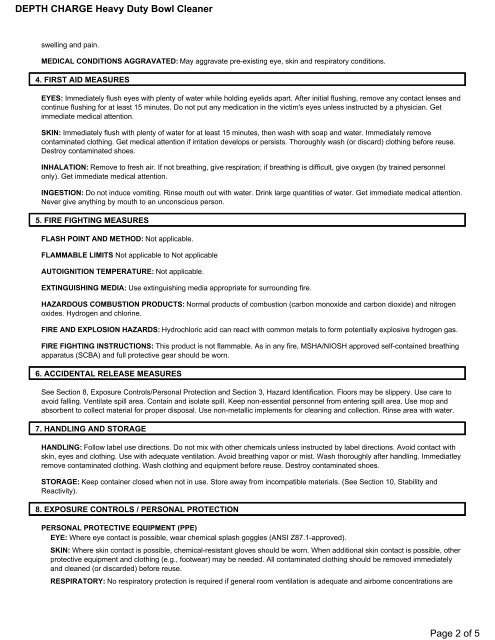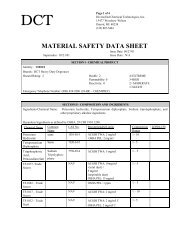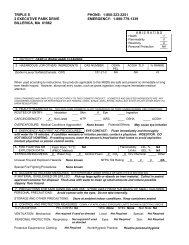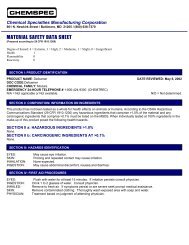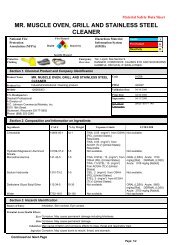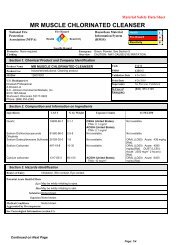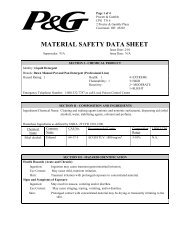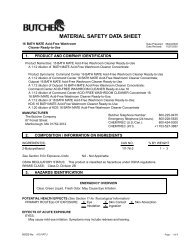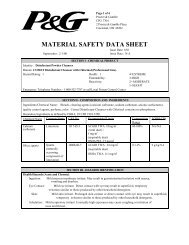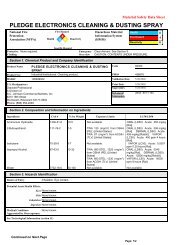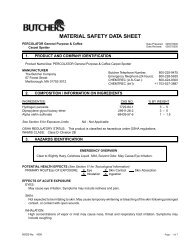DEPTH CHARGE Heavy Duty Bowl Cleaner
DEPTH CHARGE Heavy Duty Bowl Cleaner
DEPTH CHARGE Heavy Duty Bowl Cleaner
Create successful ePaper yourself
Turn your PDF publications into a flip-book with our unique Google optimized e-Paper software.
<strong>DEPTH</strong> <strong>CHARGE</strong> <strong>Heavy</strong> <strong>Duty</strong> <strong>Bowl</strong> <strong>Cleaner</strong><br />
swelling and pain.<br />
MEDICAL CONDITIONS AGGRAVATED: May aggravate pre-existing eye, skin and respiratory conditions.<br />
4. FIRST AID MEASURES<br />
EYES: Immediately flush eyes with plenty of water while holding eyelids apart. After initial flushing, remove any contact lenses and<br />
continue flushing for at least 15 minutes. Do not put any medication in the victim's eyes unless instructed by a physician. Get<br />
immediate medical attention.<br />
SKIN: Immediately flush with plenty of water for at least 15 minutes, then wash with soap and water. Immediately remove<br />
contaminated clothing. Get medical attention if irritation develops or persists. Thoroughly wash (or discard) clothing before reuse.<br />
Destroy contaminated shoes.<br />
INHALATION: Remove to fresh air. If not breathing, give respiration; if breathing is difficult, give oxygen (by trained personnel<br />
only). Get immediate medical attention.<br />
INGESTION: Do not induce vomiting. Rinse mouth out with water. Drink large quantities of water. Get immediate medical attention.<br />
Never give anything by mouth to an unconscious person.<br />
5. FIRE FIGHTING MEASURES<br />
FLASH POINT AND METHOD: Not applicable.<br />
FLAMMABLE LIMITS Not applicable to Not applicable<br />
AUTOIGNITION TEMPERATURE: Not applicable.<br />
EXTINGUISHING MEDIA: Use extinguishing media appropriate for surrounding fire.<br />
HAZARDOUS COMBUSTION PRODUCTS: Normal products of combustion (carbon monoxide and carbon dioxide) and nitrogen<br />
oxides. Hydrogen and chlorine.<br />
FIRE AND EXPLOSION HAZARDS: Hydrochloric acid can react with common metals to form potentially explosive hydrogen gas.<br />
FIRE FIGHTING INSTRUCTIONS: This product is not flammable. As in any fire, MSHA/NIOSH approved self-contained breathing<br />
apparatus (SCBA) and full protective gear should be worn.<br />
6. ACCIDENTAL RELEASE MEASURES<br />
See Section 8, Exposure Controls/Personal Protection and Section 3, Hazard Identification. Floors may be slippery. Use care to<br />
avoid falling. Ventilate spill area. Contain and isolate spill. Keep non-essential personnel from entering spill area. Use mop and<br />
absorbent to collect material for proper disposal. Use non-metallic implements for cleaning and collection. Rinse area with water.<br />
7. HANDLING AND STORAGE<br />
HANDLING: Follow label use directions. Do not mix with other chemicals unless instructed by label directions. Avoid contact with<br />
skin, eyes and clothing. Use with adequate ventilation. Avoid breathing vapor or mist. Wash thoroughly after handling. Immediatley<br />
remove contaminated clothing. Wash clothing and equipment before reuse. Destroy contaminated shoes.<br />
STORAGE: Keep container closed when not in use. Store away from incompatible materials. (See Section 10, Stability and<br />
Reactivity).<br />
8. EXPOSURE CONTROLS / PERSONAL PROTECTION<br />
PERSONAL PROTECTIVE EQUIPMENT (PPE)<br />
EYE: Where eye contact is possible, wear chemical splash goggles (ANSI Z87.1-approved).<br />
SKIN: Where skin contact is possible, chemical-resistant gloves should be worn. When additional skin contact is possible, other<br />
protective equipment and clothing (e.g., footwear) may be needed. All contaminated clothing should be removed immediately<br />
and cleaned (or discarded) before reuse.<br />
RESPIRATORY: No respiratory protection is required if general room ventilation is adequate and airborne concentrations are<br />
Page 2 of 5


